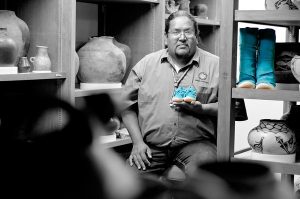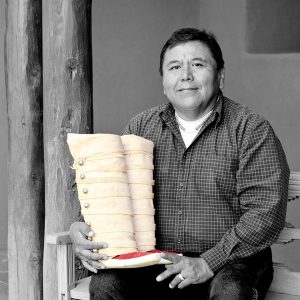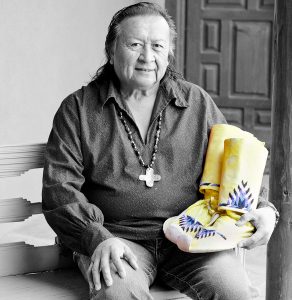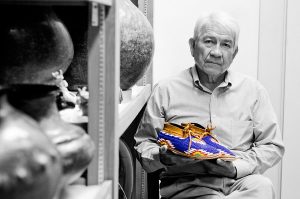October 22–23, 2010
During the two-day seminar, the group reviewed historic photographs and the IARC moccasin collection. This was the second time they had viewed the moccasins, and this time they began preliminary selections of moccasins to include in the banner exhibit as images, since no collection items will travel with the exhibit. The moccasin makers also brought pairs of “moccasins in progress” and worked on them, and they shared techniques with one another.
IARC Director Cynthia Chavez Lamar will continue working with the group the rest of this year into 2011, with the hope that she can reconvene the artists in July 2011 to begin review of the draft exhibit content and images. The banner exhibit is tentatively scheduled for completion in June 2012, and will begin traveling to local venues in New Mexico and Arizona shortly thereafter.
Sponsored by Anne Ray Charitable Trust
Patricio Tenorio

Patricio Tenorio
Santo Domingo Pueblo
Pat has served as tribal councilman of Santo Domingo. He practices and maintains the traditions of his pueblo, which is why he learned how to make moccasins. He observed his grandfather and father making moccasins while he was growing up. Pat started making moccasins in March 2000 and learned through classes offered at the pueblo, which were taught by Lambert Nieto.
Making moccasins is a great part of Pat’s life. He always likes to share his knowledge with anyone who wants to learn how to make shoes. He plans to continue making them for the rest of his life so he can keep up the tradition.
Edwin Herrera

Edwin Herrera.
Cochiti Pueblo
Edwin has been making moccasins for approximately 15 years. He learned out of necessity and initially began making moccasins for his family members. Edwin is primarily self-taught but he also goes to other moccasin makers for advice.
People have found out about Edwin’s moccasin making by word of mouth since he does not advertise his work or sell his moccasins at art shows. He is privileged and honored to have made moccasins for people from every pueblo in New Mexico.
Edwin hopes to pass on his knowledge to younger generations so they can keep the artistic tradition alive.
William B. Tsosie, Jr.

William B. Tsosie, Jr.
Navajo
Will’s Navajo clans are coyote-pass people (mother’s clan) born for where the two rivers meet people (father’s clan). His grandfather clans are red streak cheek people (paternal grandfather’s clan) and folded arms people (maternal grandfather’s clan). Will resides in Shiprock, NM for now but considers Tsaile-Lukachukai, AZ home also. He is married to Janice Toya-Tsosie from Jemez Pueblo, and they have two children and five grandchildren.
Will has a bachelor of arts degree in anthropology and a bachelor of arts degree in southwest studies from Ft. Lewis College in Durango, CO. Currently, he is working for the Navajo Nation Archaeology Department in the Shiprock, NM office as a field archaeologist and ethnographer. Will’s professional work has taken him throughout the greater Four Corners region of the southwest and the Navajo Nation reservation. Some of his academic and scholarly interests include Navajo rock art, ceremonial systems, material culture, and language.
Will learned how to make moccasins from watching family members make moccasins. He has a love for the material culture of his people and has tried to continue the traditions of his culture.
Herb Stevens

Herb Stevens
San Carlos Apache Tribe
Herb has been the director of the San Carlos Apache Cultural Center since 1995. As director, he oversees the exhibits and programming and also serves as a teacher and ambassador for Apache culture and traditions. He learned how to make moccasins from his grandmother and grandfather, both of who also shared many other teachings with him. He earned his bachelor’s and master’s degrees in fine arts from Northern Arizona University.
He has taught moccasin making, dress making, and shirt making in his community and at other Apache tribes. Herb often volunteers his time because he wants Apache people to carry on their traditions. He thinks it is important for Apache people to learn how to make moccasins and traditional clothing and also to wear moccasins every day.
Herb’s teaching and commitment to his culture was recently recognized when he received the Arizona Living Indian Treasures Award in recognition of his dress and moccasin making at a ceremony at the Heard Museum in October 2011. He will continue to teach as long as he can so he can continue in the steps of his elders who have gone onto the spirit world.
John Garcia

John Garcia
Santa Clara Pueblo
John has been making moccasins for 15 years. He is married and has two sons and three grandchildren whom he has made moccasins for throughout the years. He also makes drums, furniture and pottery, and paints in oil and watercolor, as well as tanning buckskin using traditional methods. He is retired from Los Alamos National Laboratories, where he was a project design engineer.
Gary S. Roybal

Gary S. Roybal
San Ildefonso Pueblo
Gary was born in 1951 and was raised in San Ildefonso where he continues to live. He has two sons, Gary Alan Roybal and Timothy Roybal, and two grandchildren, Sara and Tonita. Gary is a former tribal official, having served three 2-year terms of office as 1st and 2nd Lieutenant Governor and one 2-year term as Head War Captain and Assistant War Captain of San Ildefonso.
His grandfather, Juan Cruz Roybal, taught Gary moccasin making more than 30 years ago. Today, Gary primarily makes traditional pueblo style moccasins which includes women’s, men’s and children’s white moccasins with black soles and red moccasins with white soles. Both styles are made with either brain tanned or commercial buckskin, and the soles are brown or white cowhide. He also makes Taos/Plains style beaded moccasins, which can be fully beaded or plain. He uses glass or cut beads and sews primarily using a “lazy-stitch” with geometric lines or Pueblo Indian designs onto commercial buckskin.
Gary has participated in SWAIA’s Indian Markets and New Mexico State Fair. He has taught moccasin making to adults at the Poeh Museum arts and crafts program at Pojoaque Pueblo.
John Garcia, Santa Clara Pueblo
Edwin Herrera, Cochiti Pueblo
Gary Roybal, San Ildefonso Pueblo
Herb Stevens, San Carlos Apache
Pat Tenorio, Santo Domingo Pueblo
William Tsosie, Navajo
